Related Research Articles

Augustine of Canterbury was a monk who became the first Archbishop of Canterbury in the year 597. He is considered the "Apostle to the English" and a founding figure of the Church of England.

Clovis was the first king of the Franks to unite all of the Frankish tribes under one ruler, changing the form of leadership from a group of petty kings to rule by a single king and ensuring that the kingship was passed down to his heirs. He is considered to have been the founder of the Merovingian dynasty, which ruled the Frankish kingdom for the next two centuries. Clovis is important in the historiography of France as "the first king of what would become France".

Gregory of Tours was a Gallo-Roman historian and Bishop of Tours during the Merovingian period and is known as the "father of French history." He was a prelate in the Merovingian kingdom, encompassing Gaul's historic region.

Clotilde, also known as Clothilde, Clotilda, Clotild, Rotilde etc., was a Queen of the Franks. She was supposedly descended from the Gothic king Athanaric and became the second wife of the Frankish king Clovis I in 493. The Merovingian dynasty to which her husband belonged ruled Frankish kingdoms for over 200 years (450–758).

Gundobad was King of the Burgundians, succeeding his father Gundioc of Burgundy. Previous to this, he had been a patrician of the moribund Western Roman Empire in 472 – 473, three years before its collapse, succeeding his uncle Ricimer. He is perhaps best known today as the probable issuer of the Lex Burgundionum legal codes, which synthesized Roman law with ancient Germanic customs. He was the husband of Caretene.
Fredegund or Fredegunda was the queen consort of Chilperic I, the Merovingian Frankish king of Soissons. Fredegund served as regent during the minority of her son Chlothar II from 584 until 597.
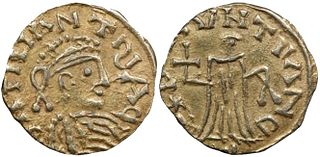
Saint Gontrand, also called Gontran, Gontram, Guntram, Gunthram, Gunthchramn, and Guntramnus, was the king of the Kingdom of Orléans from AD 561 to AD 592. He was the third-eldest and second-eldest-surviving son of Chlothar I and Ingunda. On his father's death in 561, he became king of a fourth of the Kingdom of the Franks, and made his capital at Orléans. The name "Gontrand" denotes "War Raven".

Venantius Honorius Clementianus Fortunatus, known as Saint Venantius Fortunatus, was a Latin poet and hymnographer in the Merovingian Court, and a bishop of the Early Church who has been venerated since the Middle Ages.

Saint Hermenegild or Ermengild, was the son of king Liuvigild of the Visigothic Kingdom in the Iberian Peninsula and southern France. He fell out with his father in 579, then revolted the following year. During his rebellion, he converted from Arianism to Catholicism. Hermenegild was defeated in 584 and exiled. His death was later celebrated as a martyrdom due to the influence of Pope Gregory I's Dialogues, in which he portrayed Hermenegild as a "Catholic martyr rebelling against the tyranny of an Arian father."
Brunhilda was queen consort of Austrasia, part of Francia, by marriage to the Merovingian king Sigebert I of Austrasia, and regent for her son, grandson and great-grandson.
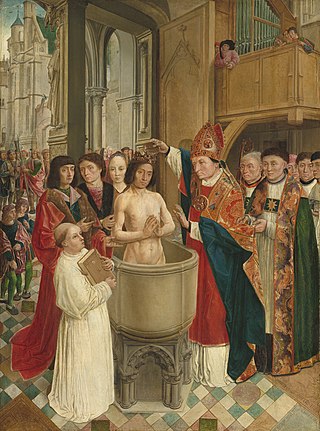
Remigius was the Bishop of Reims and "Apostle of the Franks". On 25 December 496, he baptised Clovis I, King of the Franks. The baptism, leading to about 3000 additional converts, was an important event in the Christianization of the Franks. Because of Clovis's efforts, a large number of churches were established in the formerly pagan lands of the Frankish empire, establishing a distinct Catholic variety of Christianity for the first time in Germanic lands, most of whom had been converted to Arian Christianity.
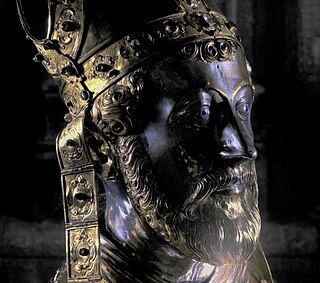
Saint Servatius was bishop of Tongeren —Latin: Atuatuca Tungrorum, the capital of the Tungri—. Servatius is patron saint of the city of Maastricht and the towns of Schijndel and Grimbergen. He is one of the Ice Saints. His feast day is May 13.
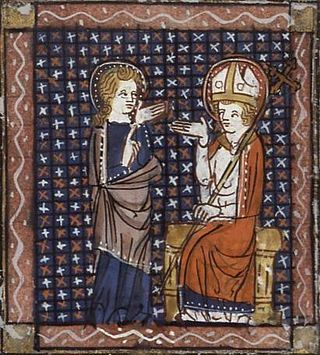
Brice of Tours was a 5th-century Frankish bishop, the fourth Bishop of Tours, succeeding Martin of Tours in 397.
Saint Prætextatus, also spelled Praetextatus, Pretextat(us), and known as Saint Prix, was the bishop of Rouen from 549 until his assassination in 586. He appears as a prominent character in Gregory of Tours’ Historia Francorum. This is the principal source from which information on his life can be drawn. He features in many of its most notable passages, including those pertaining to his trial in Paris and his rivalry with the Merovingian Queen Fredegund. The events of his life, as portrayed by Gregory of Tours, have been important in the development of modern understandings of various facets of Merovingian society, such as law, the rivalry between kings and bishops, church councils, and the power of queens.

The Roman Catholic Archdiocese of Clermont is an archdiocese of the Latin Church of the Roman Catholic Church in France. The diocese comprises the department of Puy-de-Dôme, in the Region of Auvergne. The Archbishop's seat is Clermont-Ferrand Cathedral. Throughout its history Clermont was the senior suffragan of the Archdiocese of Bourges. It became a metropolitan see itself, however, in 2002. The current archbishop is François Kalist.
Magneric of Tier was a Frankish bishop of Trier. He is a Catholic and Orthodox saint, with a feast day on July 25. Magneric was one of the first bishops with a Germanic name. He was a friend and admirer of Gregory of Tours, mentioned in his History of the Franks, and ordained St Géry, one of his disciples, who became bishop of Cambrai-Arras on the ascent of King Childebert II. Venantius Fortunatus described the Bishop as virtuous and charitable, and an "ornament of bishops".
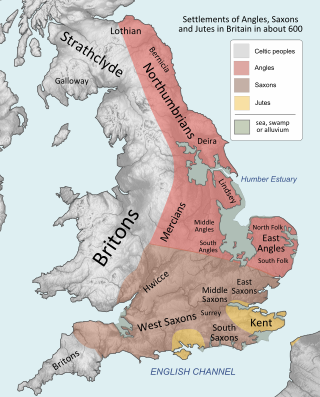
The Gregorian mission or Augustinian mission was a Christian mission sent by Pope Gregory the Great in 596 to convert Britain's Anglo-Saxons. The mission was headed by Augustine of Canterbury. By the time of the death of the last missionary in 653, the mission had established Christianity in southern Britain. Along with the Irish and Frankish missions it converted other parts of Britain as well and influenced the Hiberno-Scottish missions to Continental Europe.
Heraclius was Bishop of Angoulême. The main source about his life is the Historia Francorum of Gregory of Tours.

Palladius or more often in French Pallais was a 6th-century bishop of Saintes. According to Gregory of Tours, the family of Palladius was wealthy, and had produced several bishops and teachers throughout the 5th century in Gaul.

Christianization of the Franks was the process of converting the pagan Franks to Catholicism during the late 5th century and early 6th century. It was started by Clovis I, regulus of Tournai, with the insistence of his wife, Clotilde and Saint Remigius, the bishop of Reims.
References
- ↑ A History of the Franks. Gregory of Tours. Pantianos Classics, 1916
- ↑ http://www.cokl-db.org/cgi-bin/saint_detail.pl?saint_id=2763, Corpus Calendariam, Saint: Candidus and Malulfus, bishops (of Senlis), retrieved July 29th 2023